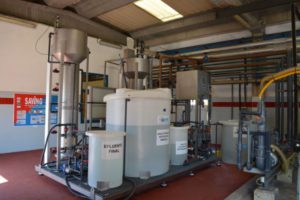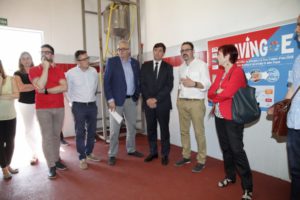02 Aug Experimental energy-sustainable wastewater-treatment-plant constructed
 UAB researchers and technicians of the DAM company will soon put into operation an experimental plant at the Rubí-Valldoreix wastewater treatment plant, with the objective of making the treatment process generate more energy than it consumes.
UAB researchers and technicians of the DAM company will soon put into operation an experimental plant at the Rubí-Valldoreix wastewater treatment plant, with the objective of making the treatment process generate more energy than it consumes.
Coordinated by professors Julián Carrera, Maria Eugenia Suárez-Ojeda, Julio Pérez and Francisco Javier Lafuente from the GENOCOV group of the UAB Department of Chemical, Biological and Environmental Engineering, and with the participation of Depuración de Aguas del Mediterráneo (DAM), the Catalan Water Agency (ACA) and the European Water Supply and Sanitation Technology Platform (WssTP), the SAVING-E project from the EU LIFE Programme aims to verify whether the wastewater treatment process can generate energy instead of consume it.
The system was already tested in laboratory, at the UAB School of Engineering facilities, and now it will be tested at pilot-scale on site at the Rubí-Valldoreix wastewater treatment plant. The total budget for the project LIFE14 ENV/ES/000633 – LIFE SAVING-E “Two-Stage Autotrophic N-remoVal for mainstream sewaGe trEatment” is €1,169,068, of which 58% is funded by the European Union.
The aim of the project is to radically re-design wastewater treatment plants so that they can produce energy with no loss – or even with a gain – in performance. Nowadays, wastewater treatment plants require a minimum energy consumption of 8-15 kWh/inhabitant/year to meet the legal requirements on effluent discharge in terms of organic matter, nitrogen and phosphorus. This means considerable greenhouse gas emissions and high costs. Eliminating these costs would mean a saving of 500 to 1000 million Euros per year in EU countries. This new wastewater treatment plant will use all organic matter in the wastewater to produce biogas, a combustible gas made up principally of methane, which can be used to obtain heat and electricity. In addition, the nitrogen in the wastewater will be eliminated autotrophically, i.e. without the need for organic matter, by means of a new technology based on two biological stages: an aerobic partial-nitritation reactor and an anammox reactor.
The pilot plant will have a total of two cubic metres and will treat three cubic metres of wastewater a day. Compared with current urban wastewater treatment systems, researchers predict a reduction of 40% in total energy consumption, 10% in nitrogen compound disposal, 20% in greenhouse gases emission, and a 50% increase in biogas production.
The first step, after the official opening, will be to set the pilot plant into operation. This step will finalise during the first trimester of 2017. Following that, researchers hope to obtain the first experimental results at the end of 2017 and the definite validation at the end of 2018.
 Attending the inauguration of the pilot plant, which took place last Thursday 07/07/0216 at the Rubí-Valldoreix wastewater treatment plant, were Margarita Arboix , UAB Rector; Jordi Agustí i Vergés, General Director of ACA; Rafael Güeto, Local Economic Development Area Councillor, Rubí City Council; Moisés Rodríguez, Environmental Councillor, Rubí City Coucil; Francisco Javier Lafuente, Vice Rector for Innovation and Strategic Projects; and Jose Antonio Andreu, Elvira César and Laura Pastor, Managers of Operation and Innovation at DAM.
Attending the inauguration of the pilot plant, which took place last Thursday 07/07/0216 at the Rubí-Valldoreix wastewater treatment plant, were Margarita Arboix , UAB Rector; Jordi Agustí i Vergés, General Director of ACA; Rafael Güeto, Local Economic Development Area Councillor, Rubí City Council; Moisés Rodríguez, Environmental Councillor, Rubí City Coucil; Francisco Javier Lafuente, Vice Rector for Innovation and Strategic Projects; and Jose Antonio Andreu, Elvira César and Laura Pastor, Managers of Operation and Innovation at DAM.




